Please click on the title Newsletter 2016 above to open the full document with the index and on any picture in this newsletter to open a larger image.
Peter Turrall, MVA Chairman
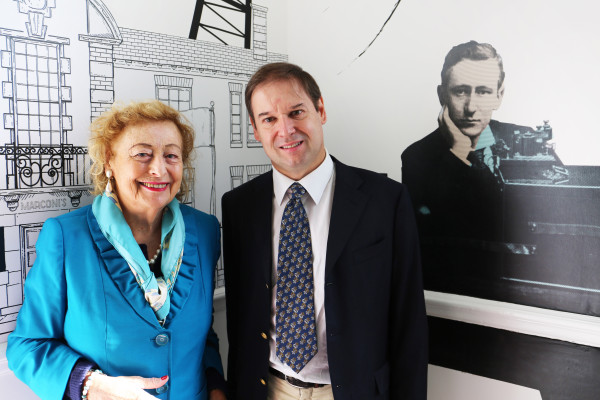
Following the presentation of an Honorary Degree of Technology at Anglia Ruskin University on Wednesday 7th October, Princess Elettra Marconi Giovanelli, the daughter of our founder Guglielmo Marconi, accompanied by her son and daughter-in-law Prince Guglielmo and Princess Victoria Marconi Giovanelli with hosts Chairman Peter Turrall and his wife Jean toured various establishments in the Chelmsford area which had some connection in the past to Marconi’s.
At a dinner on Wednesday evening at the University where the Vice Chancellor and learned Professors together with the directors of Anglia Ruskin were present, Princess Elettra thanked all concerned in honouring her with the degree which she accepted with great pleasure.
The following day a rapid tour took place.  First stop was the Marconi building in New Street, now the home of Benefit Cosmetics, an American-based organisation selling various cosmetics in the UK.  We were received here by Ian Marshall the MD and his staff who gave us an excellent tour of their building.  The original front reception area together with the Edwardian staircase is still present, but the whole of the inside has been completely brightened with light walls/ceilings etc.  The front offices depict many wireless set replicas and photographs and it was a real pleasure to see how much recognition of the work of Marconi’s has been displayed.
All the staff were anxious to know the history of the Company and what took place in the building. Â Photographs and more details of our history will be given to the Benefit company which they will gladly display in one of the rooms.
There is a number of modifications inside the building. The Directors’ Luncheon Club has been completely renovated and the partition at the rear where small dining rooms were situated, together with the kitchen area, has been removed.  The rear area has been blocked off and a small entrance door adjacent to the old surgery has been installed.  The area where the old organisation for travel arrangements and part of the photographic department is now one very large room.
My old office, once used by Marconi himself, is a reception area and on the wall various wireless sets are arranged. Â The whole organisation from MD down were delighted to see the Princess and are eager to learn more about the work of the Marconi Company.
The next visit was to All Saints Church Writtle where Princess Elettra saw for the first time the Marconi/Platt coloured glass window which was opened by her son some fifteen years earlier. Â Due to a broken ankle at that time she was unable to come to the UK herself to perform the opening ceremony. Â Following this was a visit to Melba Court Writtle where Marconi had his experimental laboratories and where work started on what became wireless broadcasting.
Then a quick visit to Chelmsford City Museum in Oaklands Park where all the Marconi equipment including cameras, and other communication items were on display.  It was then a short journey to BBC Essex in London Road to visit the plaque depicting the opening of the Chelmsford Station by Princess Elettra’s Mother, Maria Cristina Marconi. A final trip to the Marconi statue at the rear of Chelmsford bus station ended the very quick tour of Chelmsford before the Marconi family were driven to Heathrow Airport for their flight back to Rome.
As in previous years. a number of letters are from correspondents seeking information about former colleagues for research into their family history or for the preparation of articles, books, etc. If no contact detail appears with the letter then please direct your reply or any correspondence for the enquirer to.‘ Barry Powell, Secretary, Marconi Veterans Association, 22 Juliers Close, Canvey Island. Essex, SS8 7EP; 01268 696342; secretary@marconi-veterans.org or to the editor; Ken Earney, 01245 381235,” email: newsletter@marconi-veterans.org
Certain items in this issue, particularly on this and the next page, are responses to letters or articles appearing in the 2015 edition which have already been posted during the last eleven months on the website. There is thus an inevitable but necessary duplication catering for those Veterans who have no possibility, or wish, to use the internet.
Finally note that. to avoid unnecessary repetition of the Association ‘s name in full, the initials MVA have in places been used.
Gary Mortenson, deceased former R/O
Richard Fernley, richardfernley@hotmail.com,
4th June 2015
I would greatly appreciate any help you can give regarding a Marconi Marine Radio Officer – deceased.  I have tried contacting various websites and the Radio Ofï¬cers Association plus Marconi Archive at the Bodleian Library at Oxford but I received no response from them. The person in question I trained with at Norwood Technical College in London from 1969 to (January) 1972.  His name is Gary Mortenson, and he was killed on his ï¬rst trip to sea.  He was killed in a car crash in I believe British Guiana or it could have been the Virgin Islands.  He was buried out in British Guiana aged 19 years, in or around June-July 1972.
I would be very grateful if you could ï¬nd out any details of his death so that I and some of his colleagues can mark his passing and erect a ï¬tting memorial to him.
Daniel Murphy of Cork, Eire, former R/O
Aodhan O’Murchu, 3rd May 2015
My name is Aodhan Murphy and I am writing to inquire about getting information about a veteran of Marconi, My father, Daniel Murphy of Cork, worked as a radio ofï¬cer throughout the 19405 to 1960s before spending a spell working for Harrisons. He never kept a diary and, while he did speak about his time at sea, our knowledge of his career is quite limited. I’m just wondering if records are available of veterans time spent, which ships and lengths spent on board along with ports visited, are available. I have some of his log books but they don’t tell a complete story and what I would like to do is draw up a picture of his career. Please let me know what information I need to supply you with, date of birth etc, in order to avail of this information if possible. Many thanks in advance,
Le meas, Aodhan.
Barry Powell has advised Mr Murphy that we still have a D Murphy of Cork on our mailng list. To further pursue enquiries regarding his father is Marconi career he has been referred to the Bodleian Library.
Allan Thustin
Vendela MÃ¥seide, Fremstad, Norway, 30th October 2015
Allan Thustin
Vendela MÃ¥seide, Fremstad, Norway, 30th October 2015
I am Vendela Måseide I am looking for Allan Thustin.  He used to be a radio technician. My father Karl-Johan Måseide and my mother Bjorg Måseide used to be his friend and lost contact. My father is 80 years old and I think Mr Thustin is the same age.  The first time my father and Mr Thustin met was ca 1950 in Ålesund as an exchange student between the two cities. Allan came from Gloucester.  They met again in Trondheim in 1954 (give or take a year).  Allan worked for Marconi and he was working on a secret radar (or it was at that time ) on Gråkallen military area.
If he is still alive please let me know, and please forward my contact info.
Newsletter articles on the MVA website
With each issue it is often necessary to make difficult editorial judgements to cut the length of articles you send in – and limit how accompanying images are displayed – to accommodate them in a limited and even number of pages. Webmaster Chris Gardiner has no such limitation so can post the full length article and all its accompanying images, the item on the Heritage Weekend in Clifden in the 2013 newsletter being a case in point. Then all the images that Shane Joyce had sent were posted, and in colour of course.
Starting with this issue, I will supply Chris with the full length article and all its accompanying images. I hope that those of you not web-enabled wishing to see the ‘unexpurgated’ version may find a relative, neighbour or your local library, who can help you to do so.
The Marconi photo archive at the Essex Record Office
Little progress thus far in getting a volunteer team started in assisting ERO with the job of inspecting and cataloguing the former New Street photographic department’s collection of prints and negatives. The necessary precursor to this is to locate the results of a cataloguing exercise by Baddow photographic following the closure of New Street photographic department. This is proving difficult. It is hoped that more positive news may be reported at the reunion in April.
Sandford Mill Museum, Chelmsford – Open Day – Marconi Day – Saturday 23rd April, 10am – 5pm
Corrections and Comments – company names in 2015 Newsletter. Eric Peachy
Page 5 – David Griffiths
David never served as ‘Company Secretary at Marconi, latterly BAE Systems’ as stated in the Newsletter. However, he did hold the title of Company Secretary of Alenia Marconi Systems Limited (later called AMS Limited) from the 12th August, 2000 following my retirement from this position as a result of the closure of the Head Office of Marconi at Stanmore.
Page 6 – Graham Marriott
Graham refers to his employment with ‘Marconi-Elliott Avionics Systems Limited’ (please note there was no ‘s’ on the word Avionic) but this was only a Management Company with all trading and employment being carried out by Elliott Brothers (London) Limited. As the MEASL name was rather long everyone in Head Otlice at Chelmsford referred to it as MEASLS. In those far off days at New Street if you wanted an outside number (no G-Net then to other GEC Group sites!) you had to ask the switchboard operator to get it for you. On one occasion I asked the operator if I could have MEASLS at Rochester and she said “you can have measles anywhere”. I could only laugh. (Same article, p7, line 4 should read…transferred to Marconi Radar…Ed.)
Page 8 – John Brown
With reference to the NADGE Project a joint venture company was formed by the Marconi Consortium companies called NADGECO Limited registered in the Bahamas and subsequently liquidated. Similarly the competitors of the Marconi Consortium formed their own joint venture company called World Satellite Terminals Limited (WST). Once the Ascension Island Earth Station contract had been awarded to the Marconi Consortium our competitors no longer had a use for WST and it was sold to GEC on 15th July 1974, subsequently becoming a Marconi Company subsidiary on 2nd March, 1992. It went through several name changes finishing up as BAe Systems Oil and Gas International Limited in 2000. I am not aware of its current status.
Elliott-Automation Limited was created in 1957 for the purpose of creating a holding company for the Elliott Brothers (London) Limited Group of Companies. In 1966 GEC acquired AEI and in the following year English Electric bought Elliott-Automation (which included Elliott Brothers). In 1968 there was an aggressive take-over (politely called a merger) of English Electric. The Marconi Company, being an EE subsidiary since 1946, came within the takeover. However, at no time subsequent to this event did The Marconi Company become a direct subsidiary of GEC. It remained an EE subsidiary until its sale on the 30th November, 1999 to British Aerospace as it was then called.
Several Management Companies were formed on the 22nd October, 1969, amongst them Marconi-Elliott Avionic Systems Limited which did indeed report into the old Elliott headquarters at Rochester under Jack Pateman. However, Jack, as with all other MDs within the GME Group, reported to Bob Telford in his capacity as MD of GME (a Marconi Company subsidiary).
Bawdsey Radar has been awarded a Heritage Lottery Fund grant of £1.4m as part of a £1.8m project to conserve the Transmitter Block building on Bawdsey Manor Estate in Suffolk. The Transmitter Block was built in 1938 and was a key building at RAF Bawdsey, the world’s first operational radar station. The major site construction work will start in September 2016 and an exciting new exhibition will open in September 2017 allowing all visitors to explore and find out about this pioneering radar site.
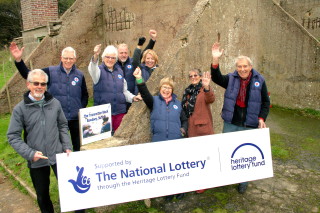 In addition Bawdsey Radar is fortunate to have been offered a grant of £196,320 by Historic England to help with the repair of this building at risk, as described by John Etté Principal Adviser, Heritage at Risk. East of England “Grade II Bawdsey Transmitter Block played a vital part in the development of radar technology during the Second World War, which also had a huge impact on post-war electronics and defence systems. Our grant will help conserve and restore this very important building by removing it from Historic England’s ‘at risk’ register. We have provided specialist support to help with the plans for a technically challenging conservation and restoration project.â€
In addition Bawdsey Radar is fortunate to have been offered a grant of £196,320 by Historic England to help with the repair of this building at risk, as described by John Etté Principal Adviser, Heritage at Risk. East of England “Grade II Bawdsey Transmitter Block played a vital part in the development of radar technology during the Second World War, which also had a huge impact on post-war electronics and defence systems. Our grant will help conserve and restore this very important building by removing it from Historic England’s ‘at risk’ register. We have provided specialist support to help with the plans for a technically challenging conservation and restoration project.â€
The condition of the Transmitter Block had been reaching the point where it would no longer have been possible to open it to the public but now, with the HLF and Historic England awards, it’s full steam ahead.
As well as plans for conserving the fabric of the building, Bawdsey Radar will be working to develop ways, physical and virtual, in which more people can visit the site and understand the importance of the radar heritage that the Transmitter Block represents. New displays within the Transmitter Block will tell the story of radar and its significance in WW2. Radar helped win the war by playing a vital part in the Battle of Britain in 1940 and it is estimated the technology helped shorten the war by two years. An important part of the project will be providing opportunities for learning about radar’s fascinating social and scientific history, and about how the early work at Bawdsey laid the foundation for our current age of electronics leading to inventions such as GPS, accurate weather forecasting, speed safety cameras and even the microwave oven!
Bob Mountfort
I read the article by Jim Cole of his time in the huts in Writtle. It awakened old memories. I was an apprentice in the next door hut with Rowland, Clark, Nolan and Buxton under the direction of LG Kemp. (A character plus). I even impressed myself, just without thinking, banging out those names from the depths. I was there from 11th January 54 to 24th June 55.  I don’t remember Jim by name but I do remember very well that one member of his hut was a sailing enthusiast. Time was spent by them in making a cannon to fire at the start, or maybe end, of races. Many experimental models were made trying to get a loud bang. Not to be left out my fellow apprentice, Mike Oldfield and I joined in the project and made experimental devices. One I made fired short pieces of Stubbs stainless steel lengths across the river in Writtle, to hit a sheet of aluminium on the other side.
Our experiments ended one lunch time when Mike blew himself up when mixing what he thought would be a faster more powerful powder. I was outside fixing my remotely fired cannon onto a big cable drum which I could roll to get the right elevation. All of a sudden there was a whoosh and smoke pouring out of the windows of our hut. I rushed in to find Mike, his glasses all white on the lenses. The powder he was grinding in a mortar had spontaneously ignited burning his hands, smoking up his glasses and burning his hair. He stood there saying, in his northern accent, “Ooh ‘eck, ooh ‘eckâ€. Lunch time – only us there. I rushed around, switched on the big extractor fan, swept up as much of his hair as I could, got him dressed in his coat, a scarf hiding his face, and gloves on his hands and escorted him out of the site, the gatemen didn’t see his face.  Put some money in his gloved hand and put him onto a bus to go to the hospital in Chelmsford.  I ran back, did a bit more tidying up and tried to look innocent when the engineers returned. The smell of burning hair was still in the hut. I can’t recall how I explained that.  Needless to say our lunch time experimenting with gunpowder stopped.  The next day Mike came to work with no hair on the front of his head, a sunburned looking face and his hands swathed in bandages.
I wonder where Mike and the others are now. I remain in touch with Colin Lewis with Christmas greetings, and I met up with him and his wife Pat when I was the Marconi Corporate representative in Riyadh, 1976 to 1979 and after when I remained working for a Saudi Sheikh until Jan 1986. Colin had come to Saudi working for the security forces. Later when I was working for Hughes Aircraft Canada as the contract manager for the Swisscontrol ATC system in Geneva, I took the train to Montpellier to meet up, and stay, with Colin and Pat in their retirement home in France. See what happens when memories are jogged!
Malcolm Frost ex Electro Optical Surveillance Division, Basildon
It was very interesting to read the article by John Wright in the January 2014 issue, it bought back a few memories of 1982. I was one of the four ‘specialists’ that John referred to and I spent four weeks in and around Baghdad. My trip started with the flight with Iraqi Airways from Heathrow to Baghdad – on a 747 Combi – I was sitting in the last passenger row just in front of pallets loaded with Coca Cola. The descent into Baghdad was interesting – all lights off (because of the war) and a tight spiral descent from 30,000 feet! First day there was to report to the Iraqi Air Force and to relinquish our passports, before then going to the British Embassy to ‘sign in’ so that they could help us with a quick evacuation if the war turned nasty. It was interesting that the war didn’t take place on Fridays as it was both sides, being Islamic, the day for prayers.
While watching the television it was interesting to hear about the war and who was winning etc. Of note was the headlines that the Iraqi forces had captured numbers of ‘shovels’ as well as tanks, field guns etc; the ‘shovels’ always had priority, so what was the ‘shovel’?  It turned out to be what we would know as a big bulldozer – very important for digging trenches in the desert.
I was fitting equipment to the helicopters and instructing the Iraqi support team to do the same, all under the watchful eye of the German helicopter manufacturer’s representative. He was over in Baghdad for six months and had his wife with him. It turned out that his wife was confined to their hotel when on her own as it was too dangerous for any western woman to venture out on her own as many Iraqis people viewed all western woman were women of easy virtue! This was proved a few days later when a team from GEC Automation arrived at our hotel in connection with the Baghdad underground transit system; one of the managers bought his secretary with him – a tall lady – who decided to go out for a little walk one evening. Shortly afterwards she returned and obviously had been in some sort of skirmish! It transpired that she had been attacked by two Iraqi men within 100 yards of the hotel; her account was that she broke one mans arm and hurt the other in a certain place. It was a good job she was big and could look after herself.
On one Friday the Air force arranged for a driver to take us to see the Hanging Gardens of Babylon as well as some other sights (mostly tank and gun emplacements!), it was a good day out. On my leaving Baghdad I can agree with John that it was every man for himself in getting to the aircraft and getting a seat, armed guards with fixed bayonets meant you had to watch carefully what you were doing. I took a short flight to Amman in Jordan for a few days rest (including a visit to the Dead Sea) before the flight home on British Airways. Â No rest for the wicked as I was immediately sent to Manchester to measure up an RAF Nimrod to enable us to fit a large stabilised thermal imaging piece of equipment into it: we were now at war over the Falklands!
And welcome to 2016.
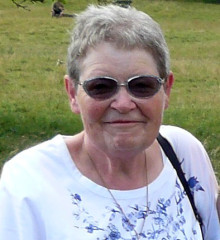 I always seem to be out when a Veteran calls – usually round the corner checking on my mother (she’s 95 now and still lives on her own) so the call is usually answered by my wife, Christine – otherwise known as the Secretary’s Secretary or ‘er indoors’. Now, as most of you know my ugly mug, I thought it might be good to include a picture of Christine so that you can put a face to the voice. I often joke that the last ‘Marconi office’ left is a cupboard at one end of our kitchen – well here’s a photograph to show what I mean.
I always seem to be out when a Veteran calls – usually round the corner checking on my mother (she’s 95 now and still lives on her own) so the call is usually answered by my wife, Christine – otherwise known as the Secretary’s Secretary or ‘er indoors’. Now, as most of you know my ugly mug, I thought it might be good to include a picture of Christine so that you can put a face to the voice. I often joke that the last ‘Marconi office’ left is a cupboard at one end of our kitchen – well here’s a photograph to show what I mean.
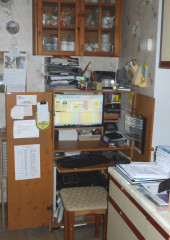 With the new year comes a new venue for our committee meetings. Parking at our usual venue of Eastwood House has become extremely difficult of late, so we were pleased to be offered a new venue. The new tenants of the 1912 building on New Street are Benefit Cosmetics, a San Francisco based cosmetics company, who have kindly offered to host our committee meetings. At this point we would like to thank BAe for kindly hosting our meeting for the past 8 years and also the Marconi Club for their offer to accommodate us. We are all looking forward to coming home. Whilst on the subject, we must not forget to record our thanks to Selex ES who have kindly supported us for a number of years now.
With the new year comes a new venue for our committee meetings. Parking at our usual venue of Eastwood House has become extremely difficult of late, so we were pleased to be offered a new venue. The new tenants of the 1912 building on New Street are Benefit Cosmetics, a San Francisco based cosmetics company, who have kindly offered to host our committee meetings. At this point we would like to thank BAe for kindly hosting our meeting for the past 8 years and also the Marconi Club for their offer to accommodate us. We are all looking forward to coming home. Whilst on the subject, we must not forget to record our thanks to Selex ES who have kindly supported us for a number of years now.
With regard to the subscription, we are pleased to maintain the rate at £6.00 per annum and are also pleased to hold the cover price for the reunion at £25.00.
Please note that the date of the reunion is Saturday 16th April where our President will be Veteran Valerie Cleare who, for many years, was Secretary/PA to a number of Directors and Senior Management within Marconi Communication Systems at New Street, Chelmsford including the MD of MIMCo. Guest of Honour is Mr John Shrigley, Director of Personnel of GEC-Marconi Electronics Ltd during the second half of the 1970s. Last year’s reunion again passed off without any problems so I do not envisage any changes for this year.
With regard to the name tags, last year’s arrangements seemed to work quite well so we will, again, produce the name tags on A4 sheets which will be at the merchandise table so you can collect your label as you enter the hall. When you order your ticket, please indicate, in the box provided, how you would like your tag to read. If you attended the reunion last year, it will read the same, otherwise, the default will be to print your name as it appears on the first line of your address label.
Two of the frequent reasons I hear for not coming to the reunion are “I won’t know anyone†and “It’s only managers isn’t it?†To answer the first, I would think it’s unlikely that, out of the 170 or so Veterans at the reunion, there is not someone that you have come across in your 21 or more years with the company. In any case, everyone at the reunion is friendly and welcoming. Which brings me to the second reason; Marconi initiated the Association in order to acknowledge the contribution made by long serving employees at all levels. Any employee that has served for 21 years or more, at whatever level, is a Veteran and all Veterans are invited to the reunion and the ‘friendly and welcoming’ point above is just as valid. If you are still unsure about attending or have any questions, please give me a ring. I am always happy to talk and can give you names of those Veterans who attended recent reunions.
If you know of an ex-Marconi employee who does not receive the newsletter please urge them to contact me as soon as possible. It may be that they have moved or not replied to a confirmation request of a few years ago or that they left with 21 to 24 years service and have now become Veterans by virtue of the reduction in service requirement to 21 years. The ‘Friends of The Marconi Veterans’ Association’ has been set up to cater for anyone who does not qualify as a Veteran but wishes to be kept informed of things Marconi. Numbers are growing slowly with, currently, approaching 70 members and any more would be welcome. The three registers (the Main register, In Memoriam and Friends) are now published on the website so please have a look if you can and let me know of any errors.
Please note that I may be contacted at the address below. Finally, I would like to wish you all a very prosperous 2016 and hope to see as many of you as possible either at the reunion this year on 16th April or the next Open Day at Sandford Mill.
One final note – the 2017 Reunion will be on Saturday 22nd April.
Barry Powell, Secretary, Marconi Veterans Association, 22 Juliers Close, Canvey Island, Essex, SS8 7EP Phone: 01267 696342 (answerphone if we are out, please leave a message and I will ring you back) Email: Secretary@marconi-veterans.org
Advertisement for a restaurant in Ankara
You are invite to visit our restaurant where you can eat Middle East Foods in a European ambulance.
The reunion took place on the 18th April 2015. Our President at the reunion and for the past year has been Basil Francis, ex-Chief of the IDO, New Street and the Guest of Honour was John Warwicker MBE, retired Metropolitan Police Officer and author.
The toast to the President was proposed by MVA Chairman Peter Turrall. In his opening remarks he noted that he and Basil Francis enjoy a friendship reaching back 64 years; Basil was best man at Peter’s wedding in 1954. During those years they have played golf and badminton together many times.he reunion took place on the 18th April 2015. Our President at the reunion and for the past year has been Basil Francis, ex-Chief of the IDO, New Street and the Guest of Honour was John Warwicker MBE, retired Metropolitan Police Officer and author.
Chelmsford born and bred, Basil started life with MWT in 1939 as a draughtsman and progressed through the company in installation design of broadcast equipment, retiring as Chief of IDO in 1989, throughout that time collaborating with our chairman on overseas contracts on many occasions
He opened by thanking the association for choosing him as its President for the year. He joined the company in 1939 in the Installation Design Division at Great Baddow after a brief spell working at Crompton Parkinsons. Shortly after he moved, with the IDD, to New Street, attended evening classes at METC studying for ONC and HNC in mechanical engineering whilst, mentored by senior draughtsmen, learning installation techniques . Studies interrupted by a break of five years until 1946 for war service as a pilot in the RAF on Catalinas, Wellingtons and Dakotas he then returned to work in the IDO, and resumed studies to gain ONC and HNC, further progressing through the IDO to retire as chief of the department in 1989. The IDO serviced all main MCSL divisions, and one aspect, outside broadcast television vehicles, was to become a forte.
He described a somewhat itinerant working life, with the IDO moving around various temporary locations at New Street before finally settling in a room on the first floor of the canteen. Work over many years involved making visits to customers overseas to liaise with their engineers and architects where buildings were to house Marconi equipment. He concluded by remembering a number of well-known names with whom he had the privilege of working over his 50 years, from B N McClarty and Douggie Smee through David Speake, Bill Barbone, Derek Griess to Tom Mayer, present at the reunion that day.
The chairman then introduced Basil’s guest, former Metropolitan Police Officer John Warwicker MBE. He has local connections, being educated at KEGS during the war years, and family connections with Marconi’s. The author of a number of books including one recently published entitled ‘An Outsider Inside Number 10’ describing his time as a close protection officer to three prime ministers, provided the theme for his talk.
Following school he spent a brief period at Lloyds Bank before entering the Metropolitan Police, in 1954 joining Special Branch at Scotland Yard, mainly involved then with anti cold-war activities, principally counter-espionage, protection of VIPs and dignitaries. After a period firmly established in this area he was transferred to Downing Street to take a lead role in the protection of the prime minister, at that time Harold Wilson, a role rapidly expanding in importance and authority.
This turned out to be one of the most entertaining times of his life and there were many funny stories to tell about it. How at the Commonwealth Prime Ministers’ Conference in Jamaica in 1974 Harold Wilson came out of a gruelling three hour long debate to be surrounded by a host of advisers, diplomats, press officers seeking comment or instant decisions on this and that. Pacing up and down looking increasingly anxious, it became apparent that he seemed to be the only one of Harold’s staff who realised that he was desperately seeking the gents’ and couldn’t find it. Finally finding it and entering he was followed by the entire posse who lined up with him at the urinals – and one his advisers dropped into the urinal a sheaf of official papers that had been clamped under his arm. As he was the only official authorised to have charge of them, he had the responsibility for recovering them and drying them out before re-presented them!
Apparently James Callaghan had no sense of humour and there were no really interesting stories to retell of that period, but everything changed with Margaret Thatcher. Like her or loathe her, she was an impressive performer, and in his view, unlike Callaghan, did have a sense of humour, although perhaps not a great one.
He related one memorable anecdote from this time when she was attending the Commonwealth Prime Ministers’ Conference in Lusaka in 1979. This was not long after her assumption of the premiership, something of a steep learning curve which she had handled well. But this was the conference which led to the ending of white supremacy rule in Southern Rhodesia (Zimbabwe), and on the fifth day, after a particularly gruelling session attempting to secure a settlement on Rhodesia, Mrs Thatcher, in the car returning her and Denis to their hotel, appeared very downcast, feeling she had let down the white Rhodesians, to whom she felt a special loyalty. Denis however had had a wonderful day visiting a game park, a copper mine, playing golf, being entertained royally, and he regaled her with a report of all this, then suddenly realised that she had obviously not had a good day and said “The only thing I’m really sorry about is that I haven’t seen enough of you todayâ€. She looked across at John Warwicker and said “I don’t know what you think Mr Warwicker but I really don’t think there’s going to be time for any of that today, do you?†So it wasn’t that she didn’t have a sense of humour, it was perhaps not well developed.
Heavily edited extracts from the speeches to give a flavour of the proceedings. Full texts can be found on the MVA website.
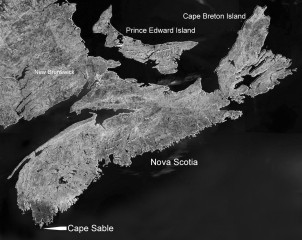 In the 2013 newsletter we published an appeal from Desirée Martin for any information any veteran might be able to provide concerning the writer of a letter she had found in a second-hand book – Film Review 1956 to 57 – bought in a junk shop in Abbots Langley in the 70s. The writer of the letter was Edward Ginman, an English employee of the Marconi Wireless Telegraph Company of Canada, working at that time in 1907 at a Marconi wireless telegraph station at Cape Sable, Nova Scotia. This of course was the same year that Marconi’s first permanent commercial transatlantic service was established between Glace Bay, Cape Breton and Clifden, in Connemara, Ireland.  The Cape Sable station appears to have been concerned with local area ship to shore w/t traffic, i.e., out to about 200nm.
In the 2013 newsletter we published an appeal from Desirée Martin for any information any veteran might be able to provide concerning the writer of a letter she had found in a second-hand book – Film Review 1956 to 57 – bought in a junk shop in Abbots Langley in the 70s. The writer of the letter was Edward Ginman, an English employee of the Marconi Wireless Telegraph Company of Canada, working at that time in 1907 at a Marconi wireless telegraph station at Cape Sable, Nova Scotia. This of course was the same year that Marconi’s first permanent commercial transatlantic service was established between Glace Bay, Cape Breton and Clifden, in Connemara, Ireland.  The Cape Sable station appears to have been concerned with local area ship to shore w/t traffic, i.e., out to about 200nm.
There was insufficient space in the 2013 edition to reproduce the text of Ginman’s letter, but we have in this edition, so here it is. With one or two exceptions, the spelling, punctuation, capitalisation and layout are as in the original, both the letterhead and Ginman’s text.
We have not yet heard from Desirée Martin as to the success or otherwise of her enquiries, but I have e-mailed her for an update, and two possible sources of further information about the Cape Sable station in Nova Scotia, the museum in Glace Bay and the community library at Clarks Harbour. Internet searches so far have yielded a little, but we might have further information to report next year. Ed.
Marconi Wireless Telegraph Company
of Canada Limited.
Cape Sable Station Jan 6 1907
Shelburne Co, N.S.
Dear Mr Dutton
I wish you all a very bright & prosperous New Year, am sorry I have not written you before, but, it’s the old tale, keep putting it off till another time.
Well, I am glad to say I am getting along first rate, good health, good job & the last & not least a good salary. I have been in the Canadian Co since last June, was at Halifax station six months & have been here since, so you see I haven’t been about much at present. This station is situated on a very small island on the extreme New York end of Nova Scotia, we have a passage to cross in a small boat to reach a larger island & then a team (wagon) ride of about 3 miles & then take a steam ferry to the Mainland, the nearest village is Clarks Harbour which is about 4 miles from the station, we have a mail every day so you can judge for yourself near about how we are fixed. The only other occupants on her are the lighthouse keeper & crew. We are four on the station all Englishmen, with a woman cook, so taking everything into consideration we are fixed up in good style.
How are things going down your way? I would like to have a look at you all, cant say when I will be able to come home, but must hope for the best. What sort of Xmas did you spend? We made the best of a quiet time, had turkey and Xmas pudding for dinner so we didn’t do so bad. Say, is old Dennis still knocking about down the bridge? the old fellow who built the houses over the bridge, I mean. We had some very funny weather here lately, one day cold & the next mild rain. We have had a little whaling, but not much at present, guess we have that to come.
Bert seems to be getting on well out at Muskegon, I received a nice letter from him on Saturday. My eldest brother is at the station west of us now, we do not communicate because he is in the American C/o & this is the Canadian Co, his little girl, (Alma), had to go under an operation a short time ago, but he tells me she is almost herself again now. Next spring, I guess, I will be shifted again, don’t know for certain where they will put me this time.
I have been away from home over six months now, but it don’t seem to strike me we are 3000 miles apart, guess we will soon be working wireless across the Atlantic, in about 6 months I guess.
Well I think I must close, am on night duty this week & the cook is getting breakfast so must quit
Wishing you and yours the very best of health & luck
from Yours Sincerely
Ernest Ginman
P.S. A letter is always welcome, ha! ha! NAY
Allen Buckroyd (taken from Great Baddow Oral History)
Between 2000 & 2003 I compiled Great Baddow Oral History based on oral interviews of residents of Great Baddow, people later providing additional snippets of information. The following transcript of an interview with the wife of the local doctor is from an audiocassette provided by Diana Fawcus, (née Spencer-Phillips) grand-daughter of the interviewees. It was probably dictated around 1970 (since reference is made to Baddow bypass, built in the late ‘60s) to an unknown lady interviewer, possibly from a local newspaper or Essex Record Office.
The interview took place in the Dower House, built by the Spencer-Phillips in 1954 behind ‘Yews House’ (sometimes known as Youse), No 4 High Street, Great Baddow, former home of the village doctor for many years.  ‘Youse’ and the Dower House are both now owned by Alan Thomson, who runs the local TV & radio business.
Vera Evans transcribed the two sides of the audiocassette on 20 December 2004. This was edited and, to aid comprehension, italicized text in red parentheses added by Allen Buckroyd on 15 January 2005.
Mrs Dolly Spencer-Phillips was born Dorothy Lister, the daughter of a well-to-do doctor who lived at Noakes Place, a posh house in Baddow Road. Hence she was one of the landed gentry. The following short extract covers her recollection of G Marconi.  Earlier pages describe the family’s way of life, looking after the poor of the village, dinner parties with the upper set of Baddow society.
Dr Percy Spencer-Phillips’ family originally came from Danbury, although he was brought up in London. He came to Great Baddow in 1911 to join Dr Lister, and subsequently married the boss’s daughter and took over the practice.
Interview with Dr S-P
Q: You were saying that when you came back from the First World War the practice, and perhaps Baddow itself, was changing tremendously.
Dr: Changing enormously. Marconi had come in then. It was a different place. They were here when I came back from the First World War. (By ‘here’ he must mean Chelmsford, since my understanding is that Baddow Research was not built until 1937.)
Mrs S-P: Surely not before the children were born? (some debate over when Marconi arrived in the district)
Q: Until then it had been very rural?
Dr: It was very rural. It was a self-contained little community. Everybody knew everybody. If anybody wanted help they would go to one of the big houses and it was forthcoming. Everyone helped one another and everybody was as happy as could be. [Mrs S-P interjects: our village nurse was run by the surgery, with no help from the government].
Q: More nurses came when the (housing) development started?
Dr: When Marconi’s came they took over the farmland and started building on it. It has grown & grown & grown.
Interview with Mrs S-P
Q: There was one other thing. Do you remember Marconi?
Mrs S-P: Yes, I do very well.
Q: Can you tell me how you came across him?
Mrs S-P: I can just remember what he looked like. I remember so well, mother and father discussing Marconi who had just come to live here. He was living over a furniture store in Chelmsford. I’m absolutely certain about that. Have you seen Reg Spalding? (This probably suggests talking to the local farmer who kept a journal relating to the period in question). He (Guglielmo Marconi) came down as a young man (around 1899) and rather stirred up the engineers of the neighbourhood. I don’t know who they’d be. Clarkson or something like that. He built one of the first factories in Chelmsford. I can’t remember if they were Clarkson or one of that lot. Anyway he came down. I remember father so well, suggesting that mother should get in touch with him. It was just rather difficult because he was a foreigner, to begin with, and didn’t fit in with this neighbourhood. Then it was rather different. So he was ignored and nobody bothered with him. Our friends in Chelmsford said we ought to do something about it because he was rather a clever student and had great ideas. However nobody bothered very much with him.
Then of course after(wards), people would have given their (eye-teeth?) to look after him and said “you know, he is a very clever young chap and I think that we should get in touch with himâ€. I remember mother saying, “I don’t want to bother, he’s a foreignerâ€. So he was ignored. I think possibly she thought that I might fall in love with him. He certainly was not asked into our house and he wasn’t accepted around the place. He was a really clever man and it was the Pitseys(?) who looked after him, and said,†I think that there is something in that man. I think that he should be asked to dinner and to give him hospitalityâ€. However we did nothing.
Then afterwards I remember this lovely countryside (on the outskirts of Great Baddow) where we used to pick all sorts of wild flowers. We were going for a walk one day with the children, and saw a huge bulldozer in the field. (Date presumably about 1937.) I said, “What on earth is it doing here?†“Didn’t you know, Marconi’s is putting up this enormous research station?†That grew and with that came the houses – rows & rows & rows of them. We can’t get out now. (She means ‘we cannot walk from our garden to Galleywood’, as the so-called Marconi estate is in the way.)
Alan Hartley-Smith
Although we didn’t have a report in the 2015 Newsletter there was one posted on the web site continuing with the work of the Marconi Heritage Group and the efforts being made to get better physical recognition for Marconi in Chelmsford.
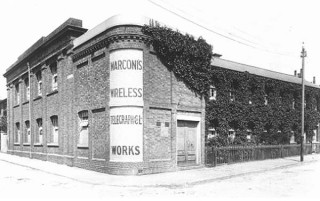
The concentration of activity during most of 2015 was on the potential acquisition of the original Hall Street factory. Having discovered that a planning application had been made to convert it into flats considerable effort was made to mount an appeal to prevent this, but unfortunately this proved unsuccessful as at the planning meeting held in December 2014 the application was approved.
A prerequisite of the permission was that the building must be open to the public for 3 months following the refurbishment. As a result of the planning committee meeting the Chelmsford Civic Society set up a sub-group (Marconi Science Worx) to liaise with the developer about the possibility of purchasing the commercial space, 2000 sq feet, for a dedicated Marconi Heritage Centre and to that end a crowd-funding project was set up to raise funds; this proved to be a bridge too far and did not reach its target. Continuing discussions have resulted in a council-proposed three-month exhibition in the ground-floor area about the Marconi-related occupation of the building.
This will be a volunteer-led initiative, open every Friday and Saturday from 11th March to 29th May from 11am to 3pm, other days and times by appointment, and is being curated by Tim Wander. There is to be a private view on Friday 18th March for City and County Councillors and invited guests where Tim Wander will give a talk.
During the 3 month period the following talks will be given from 7pm. Tickets £5, to book go to: www.chelmsfordcivicsociety.eventbrite.com
| 18th March 7pm for 7.30 | Tim Wander | |
| 1st April 7pm for 7.30 | Ray Clark BBC Essex | |
| 14th April 7pm for 7.30 | Tim Maltin - Titanic historian and author - The role of Wireless in the Titanic tragedy | |
| 22nd April 7pm for 7.30 | Dr Elizabeth Bruton - Oxford University – The Battle of Jutland |
These are being organised in conjunction with the Chelmsford Civic Society with the support of the City Museum Service and BBC Essex and we are seeking volunteers to man the events, so if you can spare some time please contact their coordinator Pam Swaby – tpswaby@blueyonder.co.uk This is probably the final opportunity to convince the local authorities to lend full support to the proper recognition of the contribution made by the Marconi Companies to the development and prosperity of Chelmsford and other Essex locations. Also to support the exhibition Tim Wander is producing a new book about Hall Street from its first use until the move to New Street. Copies will be available for sale. See details on next page.
On the Group website the wikis recording personal and company information continue to grow; to contribute you can register an interest on this website: <https://sites.google.com/site/callingoldmarconipeople/> then send material to the relevant editor, or email it to myself directly or via the MVA, and also apply for access to the wikis.
For the Changing Chelmsford Ideas Festival 2015 in October we again collaborated with the Chelmsford Science and Engineering Society in organising a lecture from Tim Wander our own historian, ‘Guglielmo Marconi’, telling the story of building the wireless age, as for over 100 years the Marconi Company’s work in Chelmsford and Essex dominated and defined the modern age of electronics, radio, radar, television and mobile communications with its massive impact on the working and social lives of tens of thousands of local people. Tim has recently published his latest book covering the first five years of Marconi’s work, which is featured on the MHG and MVA websites.
We also participated in the inaugural Industrial Heritage Fair organised by the Essex Industrial Archaeology Group in Braintree with a presentation that included working models of early Marconi apparatus.
There are also events later in the year commemorating the First World War being organised, including a showing of the film of the Battle of the Somme in 1916 with a live orchestra accompaniment. Â Another occasion of note this year is that of the 80th anniversary of the decision in 1936 to build the Research Laboratories at the Great Baddow site. Â Plans are being made to celebrate this event.
There does appear to be growing interest in the heritage landscape but success will depend on support by both active participants and interested visitors so please encourage anyone you can to visit all of the planned events.
This is the detailed story of Marconi’s intense, five year struggle from 1896-1901 to develop a reliable and practical wireless communication system. It was a constant search for distance and reliability, often in the face of appalling weather. Step by step Marconi overcame countless technical difficulties, battling seemingly insurmountable problems of physics and engineering as his embryonic system began to take shape.
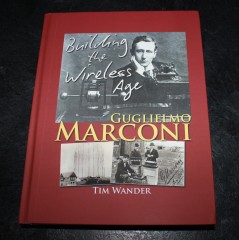 It was also a battle for public, press, commercial, military and scientific acceptance. It quickly became a war of money and ideas as Marconi fought against international and state sponsored competitors who deployed every form of industrial espionage and legal challenge. Each was determined to claim a piece of the new science and try to take control of what soon became a new industrial revolution.
It was also a battle for public, press, commercial, military and scientific acceptance. It quickly became a war of money and ideas as Marconi fought against international and state sponsored competitors who deployed every form of industrial espionage and legal challenge. Each was determined to claim a piece of the new science and try to take control of what soon became a new industrial revolution.
Twelve years in the writing and with fifteen years of research behind that – the goal of the new book was ‘simply’ to fully document the first five years of the young Guglielmo Marconi’s career. My long held passion was to pull the whole story together, step by step and site by site with as many photographs and sketches as possible. The new book tells the complete story of the difficult birth and desperate battles that took place to make a practical system of wireless communication a reality.
Throughout the story I have challenged the established history and time lines, visited every site, interviewed local historians, combed through local archives and of course recorded what still remains. I have also attempted, as an old-time wireless engineer, to re-interpret each experiment and try to understand what happened there. Hence the book contains an extensive ‘Then and Now’ appendix along with an extensive glossary and appendices that keep the technical sections out of the main text.
I have also included a personal chapter on Marconi the man – attempting to paint a portrait of this exceptional man that no one alive today has met – based in part on contemporary accounts and on his reaction to the struggles he overcame. But this is not just Marconi’s story – credit is given to all the pioneers of wireless whose names have largely been forgotten, but each of whom played their part in the amazingly rapid development of wireless communication.
In the end it was only Marconi who won through. He had the vision, self belief and force of character to build a working system and prove it under the harshest of climates. In doing so he built a huge company and a whole new industry, straight from the laboratory bench. But it was a close run thing. Many times during the first five years he nearly lost the race to tame Heinrich Hertz’s wireless waves. But what he achieved on bleak windswept cliffs and basement laboratories around Britain’s shores changed the world as we know it.
Now available. 750 pages, over 750 photographs – many of them never published before.
Hardback. RRP £24.95 plus p&p (£3.90 signed/tracked/insured).
The first 50 copies will be signed, (dedicated if asked) and numbered by the author.
Offer to all Marconi Veterans and members of the Marconi Heritage Association – a signed/numbered copy of the book for £25 including postage and packing. Please email the author direct at timwander@compuserve.com for details or order through the website marconibooks.co.uk (add comment that you are a MVA or MHA member).
Also available through Amazon.
Chelmsford Science and Engineering Society is presenting an illustrated talk at Anglia Ruskin University,
Queen’s Building (Que101), Wednesday, 2nd March 2016 18:30
Speaker: Michael Barton (formerly Controller BBC Local Radio)
This talk will include archived recordings, to trace the story of Guglielmo Marconi and his role in the development of the BBC. It will give Marconi’s own account of the first transatlantic signals, capture of Dr Crippen through radio, sinking of the Titanic, formation of the BBC, Dame Nellie Melba’s broadcast and 2MT from Writtle.
Open to anyone who wishes to attend. Â Entrance free. Â Car parking on the University campus car parks is free after 4.30 pm. Â The most convenient car park is the one in front of the Sawyers Building accessed from Hoffmans Way (1st left turn), take ticket at barrier and re-insert it into machine to lift barrier when departing.
‘The Marconi Companies and their People’ Volume 1, Number 1, August 1950
Would anyone happy to loan an unbound copy of the very first edition of the house magazine for a short period. If so please contact our webmaster Chris Gardiner, 01245 441274, email: webmaster@marconi-veterans.org
Marconi Instruments Heritage Group is trying to digitise its whole set of 20 volumes and cannot locate an unbound copy.
Malcolm Frost – principal mechanical designer and project leader ASETS
 During one of many company name changes – this time in the mid 1980s – from Marconi Avionics to GEC Avionics the Electro-Optical Surveillance Division at Basildon competed for a contract award from American Electronic Laboratories Inc (AEL) from Philadelphia to design and develop a one-off stabilised platform to be fitted on the underside of a USAF C130: this platform and all the electronic backup systems became known as ASETS.
During one of many company name changes – this time in the mid 1980s – from Marconi Avionics to GEC Avionics the Electro-Optical Surveillance Division at Basildon competed for a contract award from American Electronic Laboratories Inc (AEL) from Philadelphia to design and develop a one-off stabilised platform to be fitted on the underside of a USAF C130: this platform and all the electronic backup systems became known as ASETS.
Although there was much apprehension amongst senior management the contract was awarded and the development got under way. A team was set up under the leadership of Mel Bennett to enable this very exacting project. It was the first time that EOSD had obtained a contract direct from the USA. The main reason we were chosen was based on the expertise (probably the world leaders at the time) with airborne stabilised platforms based on experience with the ‘Heli Tele’ and other platforms being developed for the MoD.
This particular platform had some very onerous specifications to meet. Notwithstanding the conventional environmental requirements it had to house an interchangeable payload which was the size of an old fashioned dustbin! This payload (developed by AEL) was to house various missile seeker heads to evaluate their accuracy under flight conditions. Such missile heads were from the Sidewinder and Maverick missiles and at times in various combinations. The impact on our platform design was to achieve very exacting stabilisation parameters and also to get 500 plus power and signal wiring across all three fully rotational axes to the payload sensors.
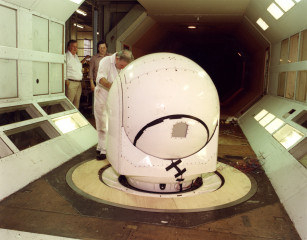 The design and subsequent manufacture resulted in a platform weighing in excess of one ton and measuring 4 feet in diameter and standing 6 feet tall, at the time a record for any stabilised platform for airborne use. Manufacture and the system design (slip rings, electro-magnetic torque motors and bearings) pushed the technology available to the limits. The production engineering department was heavily involved in selecting various techniques that could be produced in the timescales. Some of the big castings used came from a foundry that normally specialised in F1 racing car wheels using high tensile alloys, and all parts were subject to X-ray examination to ensure integrity.
The design and subsequent manufacture resulted in a platform weighing in excess of one ton and measuring 4 feet in diameter and standing 6 feet tall, at the time a record for any stabilised platform for airborne use. Manufacture and the system design (slip rings, electro-magnetic torque motors and bearings) pushed the technology available to the limits. The production engineering department was heavily involved in selecting various techniques that could be produced in the timescales. Some of the big castings used came from a foundry that normally specialised in F1 racing car wheels using high tensile alloys, and all parts were subject to X-ray examination to ensure integrity.
Another big challenge was to complete the customer acceptance criteria and specifically the environmental testing. The first hurdle was finding test houses capable of hosting a large structure, the second was transportation and logistics but British Aerospace came to the rescue at facilities in Stevenage and for the large wind tunnel testing at Weybridge.
Although we had many new problems to solve, so did AEL! The platform was to hang underneath the fuselage of the C130 on centre line and they had to develop a very sophisticated retraction mechanism inside to be able to deploy and retract our 1 ton plus monster! As the deployed platform was outside of the aircraft ‘dimensions’ special fail-safe safety designs had to be fitted to the mechanism These included an old fashioned block and tackle as back-up to the motorised design and also, as a second back-up, explosive bolts were fitted to enable the complete platform to be jettisoned in the event of the aircraft having any problems! Allegedly someone had even suggested that a long trough be dug along the centre of the runway to allow for landing with the platform deployed! This idea was soon dismissed when someone pointed out that the C130 had a centre line nose wheel!
 The whole project was a success and led to more contracts related to stabilised platforms being awarded from the USA.
The whole project was a success and led to more contracts related to stabilised platforms being awarded from the USA.
I wonder how many people remember seeing the large system being developed and built; also even the transportation from Basildon which included a large airport-style low loader lorry to enable sliding the whole package directly into the aircraft hold at Gatwick.
Mel Bennett comments: It certainly was a challenging programme and I recall doing the first presentation to AEL (with Bill Blount, Arthur Humphries and Malcolm) just after a massive snow storm in Philadelphia: we were up against tough competition and Wally Patterson was amazed when he heard we had been selected. Then he asked me if we could really do what we offered. Just shows what an A team it was in those days!
Lincsbodger
Last July, with my wife on a four day visit to Lincolnshire with our village horticultural society, I took a day off from gardens (only so many gardens a man can take in four days!) and made a long overdue visit to Lincoln. On climbing up The Strait towards the cathedral I came across J Birkett’s, the sort of ‘ex-Gov’ shop we knew in the 50s in Lisle Street in Soho, an electronics Aladdin’s Cave, a view into a bygone age. (One of the items I spotted in the window was a TR1985 which I had worked on in the RAF in the 50s.) Back home, I found Lincsbodger’s posting on a UK Vintage-Radio.net discussion forum. He’s obviously not ex-Marconi, but please forgive me for including his interesting reminiscences. Thanks Lincsbodger – Ed.
Posted by: Lincsbodger (location Lincoln) re: Birkett’s in Lincoln
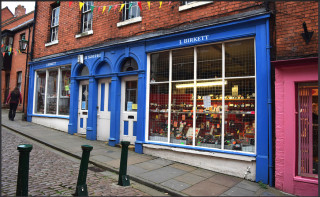 I stumbled on this forum whilst looking for info on an HMV 1126 valve radio.
I stumbled on this forum whilst looking for info on an HMV 1126 valve radio.
I used to work for Birketts in the early 1970’s. It was a fabulous time to be 18 and a fabulous place to work if you were mad on electronics, like I was.
The shop (J Birkett Radio Components) at 25/26 The Strait is incredible. When I was there it went up 3 floors and back at last 150 feet. There was literally a couple of hundred tons of electronic components in there, anything you could imagine, from unmarked Plessey 4 bit microprocessors to ex-WD 1126 radio sets. Every room, every corridor, every staircase was piled floor to ceiling with boxes.
In the 1970s, John had contacts at Marconi GEC, and was buying untested and sometimes unmarked semiconductors by the skipful. We built our own test gear, I spent many hours testing diodes, thyristors, triacs, zeners and all sort of transistors. We would sell them in mixed bags.
Similarly, he would buy vast, huge amounts of discreet components – resistors, caps, coils, all sorts. We would set up two long tables with about 50 boxes of random components in one of the rooms at the back, then you went along the row with an A4 sized zip bag, sticking a pinch of each in. These ‘mixed component’ bags sold like hot cakes at £1 each. (Remember this was 1970!)
It was a stunning, unique experience. I started playing with electronics at the age of 10 using valves, and whilst there got unlisted play with transistors then 74 series ICs. We were building Disco lighting such as ring counter and sound to lights YEARS before the big boys such as Pulsar Light of Cambridge was.
Unfortunately, the golden age of amateur electronics is over, never to be repeated. You can’t really get the components any more, and haven’t been able to for 20 years. I used to get Practical Wireless – there was always something in each issue to build, over the years I built all sorts of stuff. The one I remember the best was a sound activated flash trigger. My dad was a photographer, we took some amazing pictures of balloons and bottles bursting 1/5000 of a second after the bang.
Birketts attracted some seriously clever blokes as well. There was a guy called Joe Rose, a slow scan TV fanatic, he actually owned an entire BBC Outside Broadcast Unit complete with 4 cameras and a 2 inch tape unit and mixing desk. There was another guy who worked at the Medical Physics Dept at the hospital, he would come up with circuits for us to build and test, a seriously clever bloke. During the Winter of Discontent he invented an Inverter using two OC25 power transistors that would drive a 6 foot fluorescent tube off a car battery. We built a few and they sold like hot cakes, couldn’t make them fast enough, and we sold them as kits as well!
I went on then do TV repair as well at other places, and then had a 20 year career in Local Government IT, jumping on the IT bandwagon in the early 1980s, when jobs were plenty and the IT path was paved with gold.
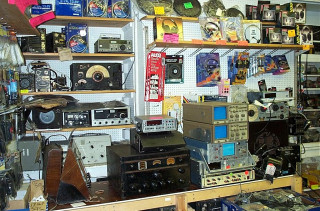 I recently built a conservatory, and we wanted an old radio in it, I got one at auction, it sort of worked, and I came to the conclusion after several weeks of messing the W77 had lost emission, and in my search for one I arrived here. I have now replaced it and the radio works pretty well. You never forget how to fix them.
I recently built a conservatory, and we wanted an old radio in it, I got one at auction, it sort of worked, and I came to the conclusion after several weeks of messing the W77 had lost emission, and in my search for one I arrived here. I have now replaced it and the radio works pretty well. You never forget how to fix them.
I pop in to see John sometimes, the shop is open Tuesdays, Fridays and Saturdays, although it long stopped being a shop, it’s really a drop in centre for old radio hams and TV engineers to have a natter. He sits in there holding court, and a long stream of old friends call by. (It still appeared to be a shop in July 2015, but not open on a Monday when I visited. Ed.)
Birketts was a legend, there wasn’t another shop like it, and there never will be again.
Malcolm Mack, ex Marconi Radar Systems
Eddie Holman, Field Services Manager, knew how to save on the subsistence budget. Never has a can of beans looked so good.
A ‘selfie’ from the beginning of 1972 showing, left to right, Ken Jacobs, Malcolm Mack and Terry Barnsley on our day off. It was taken at the beginning of 1972 at the Tropospheric site near Tabuk (Tebuk) north west Saudi Arabia. The area is south of Wadi Rum, near the Jordanian border.
Marconi Communications Systems provided most of the equipment for the Tropos and the links, plus some of their Field Service personnel. Marconi Radar Systems provided the Field Services for the installation of the radars and internal communications on Project SAGEU, and were the main contractors at the Tropo site. The picture was taken with Terry Barnsley’s camera prior to his and Ken Jacobs drive back from Saudi across Europe – via countries you wouldn’t want to be seen dead in nowadays. They had bought a Volkswagen Beetle and camping gear for the trip. Back in Europe I met them at Brand in Austria, where we did some skiing.
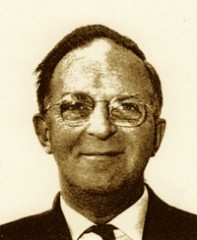 Very late in the preparation of this newsletter the death of Hugh Nigel Croke Ellis-Robinson OBE, CEng, ER to all who knew him, was announced. He died in Cornwall on the 17 January, slipping away very peacefully with both his daughters by his side.
Very late in the preparation of this newsletter the death of Hugh Nigel Croke Ellis-Robinson OBE, CEng, ER to all who knew him, was announced. He died in Cornwall on the 17 January, slipping away very peacefully with both his daughters by his side.
There is really not room at this late stage to present even a brief résumé of his life and career: wartime RAF service as a ground radar mechanic; joining Marconi in 1949; progressing steadily through the company, involved throughout with ground radar engineering; in 1982 as Programme Director Martello Projects being awarded on OBE, finally retiring in 1986. He was widely loved and respected by all his colleagues: no better tribute can be paid to him than those posted by some of them on the MOGS website over the past few days since his death.
. . . Sorry to hear of ER’s passing. One of the last of the technically-competent managers, he was a man who really earned the respect that was afforded to him. RIP – Ian Gillis
. . .Very sorry to hear about ER. I first met him when I went to work at RDG Broomfield in 1955 – but he was sorting out the SR1000 transmitter while I was working for Fred Kime on displays, so our paths did not cross very often. A brilliant engineer and a great, creative, very interesting character. I’m sure they will not make his like any more – Matty
. . . I had heard that he was not very well recently. He was a great engineer and a major contributor to the successful years of Marconi Radar. A very sad day – Roy Simons
. . . So sorry to hear of ER’s passing. The sentiments expressed by Roy sum it all up. I remember fondly those years we had at the Farnborough Air Shows – Robin Webb
. . .Very sad news. As Roy said he was a great engineer and a major contributor to the success of Marconi Radar during his time. He was also a great character and intensely patriotic, buying British made cars and insisting that publicity give-aways were wherever possible also British made.
I first joined his section at Pottery Lane in October 1957, towards the end of my apprenticeship. I was moved in June ‘58 and pestered the training department until they put me back with ER (now a Group Chief) at Baddow at the end of ‘58, completing my apprenticeship and joining the staff.
He always supported his staff, objecting strenuously if some other manager tried to criticise them, “he might be an idiot but if he is I will tell him, not youâ€. He also tried to be around whenever an urgent job required working excessive hours. Even in his latter more senior roles these were much more than token visits. I remember, when I was involved in getting the Type 88/89 (Green Ginger for the RAF) out, I turned up at Widford during a weekend to be asked by one of the testers who that bloke up on the aerial in a good suit arguing with a fitter was. It was ER arguing over the design of the gear box with the top off and oil all over the place. They were good times and it was folk like ER who made them so. The end of an era – Brian
Ted Pegram
With thanks to Gerry Valentine, Anthony Clark and Pete Kennedy
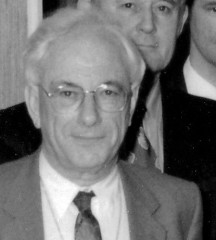 Ken Perry was born in Harrogate, but was evacuated to Blaenau in Wales during the war. After completing his education at the Blaenau Grammar School he was called up for National Service and was posted to RAF Lossiemouth where he flew low level tests and calibration flights in Lancaster bombers.
Ken Perry was born in Harrogate, but was evacuated to Blaenau in Wales during the war. After completing his education at the Blaenau Grammar School he was called up for National Service and was posted to RAF Lossiemouth where he flew low level tests and calibration flights in Lancaster bombers.
Following National Service he studied Physics and Mathematics at the University of Newcastle. After University he joined Marconi’s in the early 1950s.
Much of his career was spent at the Marconi Research Centre, followed by Marconi Radar Systems.
At the research centre Ken was Chief of the Microwave Components Group, responsible for the design and manufacture of high power microwave components for radar applications. Whilst there he became interested in High Frequency Over the Horizon Radar (HF-OTHR) technology, a subject that he made very much his own.
In 1983 Ken moved to Marconi Radar Systems to oversee the commercial exploitation of HF radar in military and civil applications. This work resulted in a number of studies, and trials with experimental systems installed on the Essex coast.
Through his work in this field GEC-Marconi became a major sub-contractor for the Australian JORN system. JORN (Jindalee Operational Radar Network) is a sky wave HF radar system that provides air and sea coverage beyond the northern coast of Australia, and has proved to be a highly successful project.
Outside his professional career Ken had many interests including music. He played the organ at St Peter’s church, Goldhanger, where he lived. He was also a keen bell ringer and was the Tower Captain at St Peter’s for fifteen years.
Nora Boswell
Alan began his love affair with ships, Morse code, etc as he watched the ships sailing out of the Tyne when growing up at Tynemouth, Northumberland. He started learning Morse code in his early teens and took out his radio license call sign – G3NOQ. He moved to Great Baddow, Essex, after university to start working for Marconi at Great Baddow as an electrical engineer. Marconi became BAE Systems and he retired from them when he was 65.
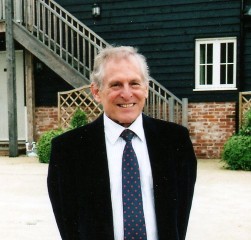 Alan had many other interests being a talented organist, madrigal and choral singer and in later life, speaker of Norwegian. He used his new found learning to translate Norwegian articles into English and made many new friends in Norway. He developed asthma which further developed in more recent years into COPD (chronic obstructive pulmonary disease) with complications. In late July he was rushed to hospital and seemed to be making a good recovery but suffered a relapse the day before he was due to be discharged. Alan is sadly missed by his son Joe, his siblings Andrew and Nora, their families and his many friends.
Alan had many other interests being a talented organist, madrigal and choral singer and in later life, speaker of Norwegian. He used his new found learning to translate Norwegian articles into English and made many new friends in Norway. He developed asthma which further developed in more recent years into COPD (chronic obstructive pulmonary disease) with complications. In late July he was rushed to hospital and seemed to be making a good recovery but suffered a relapse the day before he was due to be discharged. Alan is sadly missed by his son Joe, his siblings Andrew and Nora, their families and his many friends.
Tribute by Dr Brian Austin, G0GSF
Alan Boswell, G3NOQ, was one of the RSGB’s most respected Members. Until his death on 5th August 2015 he was an active member of the RadCom technical panel. He had particular skill in vetting articles on antenna matters. I knew Alan well from our joint involvement with the IEE (now the IET), where we met at conferences and often interacted on technical issues to do with antennas. As recently as last year we collaborated in publishing an article on small loops, along with another retired engineer and radio amateur in South Africa (Mike Perks, ZS6BIM). It appeared in the IEEE Antennas and Propagation Magazine last August. Alan’s passing will leave a huge void in the professional antenna community where he was very highly regarded.
The deaths of veterans have been reported over the year in the In Memoriam pages of the web site so will not be repeated here; the dates of joining the Marconi Company are also given. Â Please refer to these pages for the details.

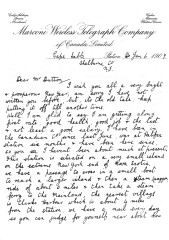
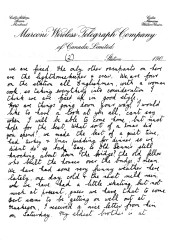
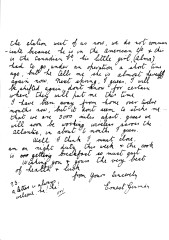

I’m not sure how to report a death of an ex-Marconi man otherwise than by this method.
I’m sorry to say that Frank Bennett, (1954) dies on February 6th at Chelmsford Care Home aged 83. He is to be cremated at Chelmsford Crematorium on Monday 2nd March at 2pm.
He spent his whole working life at Marconi Great Baddow as an RF Engineer. He was a keen sailor and was Treasurer and general handyman of Marconi Sailing Club for many years.